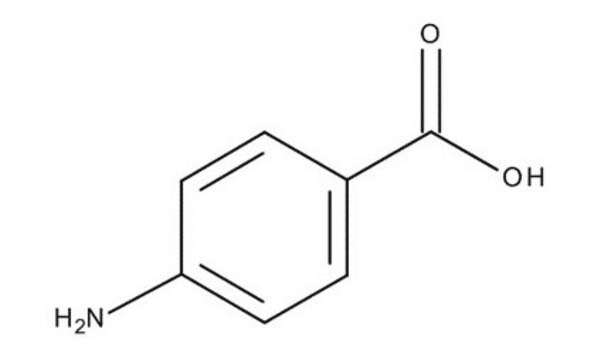100536
4-Aminobenzoic acid
99%, for peptide synthesis, ReagentPlus®
Synonim(y):
PABA, Vitamin Bx, Vitamin H1
About This Item
Polecane produkty
product name
4-Aminobenzoic acid, ReagentPlus®, 99%
Poziom jakości
linia produktu
ReagentPlus®
Próba
99%
Postać
solid
przydatność reakcji
reaction type: solution phase peptide synthesis
mp
187-189 °C (lit.)
rozpuszczalność
95% ethanol: soluble 5%, clear to slightly hazy, colorless to yellow
gęstość
1.374 g/mL at 25 °C (lit.)
Zastosowanie
peptide synthesis
ciąg SMILES
Nc1ccc(cc1)C(O)=O
InChI
1S/C7H7NO2/c8-6-3-1-5(2-4-6)7(9)10/h1-4H,8H2,(H,9,10)
Klucz InChI
ALYNCZNDIQEVRV-UHFFFAOYSA-N
Szukasz podobnych produktów? Odwiedź Przewodnik dotyczący porównywania produktów
Powiązane kategorie
Opis ogólny
Zastosowanie
- Covalent modification of glassy carbon electrode.
- Synthesis of 1,4-(2-chlorobenzylidene)aminobenzoic acid (Schiff base).
- Spectrophotometric determination of the trace amounts of dopamine, methyldopa and levodopa.
- Synthesis of 1:1 proton-transfer compound with 5-sulfosalicylic acid.
Informacje prawne
Zwroty wskazujące rodzaj zagrożenia
Zwroty wskazujące środki ostrożności
Klasyfikacja zagrożeń
Aquatic Chronic 3
Kod klasy składowania
11 - Combustible Solids
Klasa zagrożenia wodnego (WGK)
WGK 2
Temperatura zapłonu (°F)
339.8 °F - closed cup
Temperatura zapłonu (°C)
171 °C - closed cup
Środki ochrony indywidualnej
dust mask type N95 (US), Eyeshields, Faceshields, Gloves
Certyfikaty analizy (CoA)
Poszukaj Certyfikaty analizy (CoA), wpisując numer partii/serii produktów. Numery serii i partii można znaleźć na etykiecie produktu po słowach „seria” lub „partia”.
Masz już ten produkt?
Dokumenty związane z niedawno zakupionymi produktami zostały zamieszczone w Bibliotece dokumentów.
Klienci oglądali również te produkty
Nasz zespół naukowców ma doświadczenie we wszystkich obszarach badań, w tym w naukach przyrodniczych, materiałoznawstwie, syntezie chemicznej, chromatografii, analityce i wielu innych dziedzinach.
Skontaktuj się z zespołem ds. pomocy technicznej









